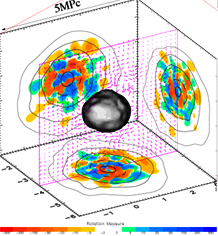
from Dolag paper

from Dolag paper
I review four decades of numerical simulations of galaxy clusters focussing on the attempts to resolve their internal structure. Overmerging describes the numerical or physical disruption of dark matter halos within dense environments. This problem was inherent in simulations prior to 1998 but can be completely overcome with current algorithms and hardware. We can now resolve many thousands of subhalos within clusters and we may have converged on their inner structure, allowing several new tests of the hierarchical structure formation model and the nature of dark matter.
KOHJI YOSHIKAWA, Y.P. JING, YASUSHI SUTO .ps .pdf
We present results from a series of cosmological SPH simulations which are designed to predict the statistical properties of X-ray clusters of galaxies as well as to study the formation of galaxies. We have several simulation runs with different assumptions on the thermal state of the intracluster gas, and all the simulations employ 2 million particles both for dark matter and gas. So, these simulations constitute the largest systematic catalogues of simulated clusters so far, and enable us to compare the analytical predictions on statistical properties of X-ray clusters in an unbiased manner. We find that the mass-temperature relation for simulated clusters is fairly insensitive to the thermal state of the intracluster gas, and agrees well with the analytic prediction. Therefore, the prediction for the X-ray temperature function of clusters on the basis of the Press-Schechter mass function is fairly reliable.L
BARBARA LANZONI, BRUNO GUIDERDONI and GARY MAMON .ps .pdf
High-resolution N--body simulations of massive dark matter halos have been combined with semi-analytical modeling, to study galaxy formation and evolution in clusters. Preliminary results about the effect of ram--pressure stripping are presented.
We present N-body, hydrodynamical simulations of galaxy clusters with and without radiative cooling. We find from the non-radiative simulations that most clusters are not well-fit by a Navarro, Frenk & White (hereafter NFW) profile, but that nevertheless the NFW model accurately predicts the temperature-mass relations. When measured within a sphere enclosing a fixed overdensity, these all follow the self-similar form,T propto M^{2/3}, however the normalisation is lower than in observed clusters. The temperature-mass relations for properties measured within a fixed physical radius are significantly steeper then this. The effect of adding radiative cooling is to raise the temperature and lower the X-ray luminosity (except in uncorrected, cooling flow clusters). This tends to bring the simulated L_X-T_X relation into agreement with the observations. We speculate that preheating of group/cluster gas may be unnecessary.
We study the evolution of magnetized clusters in a cosmological environment using magneto-hydro dynamical simulations. Large scale flows and merging of subclumps generate shear flows leading to Kelvin-Helmholtz instabilities, which, in addition to the compression of the gas where the magnetic field is frozen in, further amplify the magnetic field during the evolution of the cluster. Therefore, well-motivated initial magnetic fields of \langle B^2\rangle^{1/2}=10^{-9}\,G} reach the observed $\sim\mu{\rm G}$ field strengths in the cluster cores at $z=0$. These magnetized clusters can be used to study the final magnetic field structure, the dynamical importance of magnetic fields for the interpretation of observed X-Ray properties, and help to constrain further processes in galaxy clusters like the population of relativistic particles giving rise to the observed radio halos or the behavior of magnetized cooling flows.
TOSHIYUKI FUKUSHIGE AND JUNICHIRO MAKINO .ps .pdf
We investigate the structure of the dark matter halo formed in the cold dark matter scenario using N-body simulations. We simulated 12 halos with the mass of 4.3 x 10^{11}M_0 to 7.9 x 10^{14}M_0. In almost all runs, the halos have density cusps proportional to r^{-1.5} developed at the center, which is consistent with the results of recent high-resolution calculations. The density structure evolves in a self-similar way, and is universal in the sense that it is independent of the halo mass and initial random realization of density fluctuation as long as the halo mass is M\gtorder 3 x 10^{12}M_0. The density profile is in good agreement with the profile proposed by Moore et al. (1999), which has central slope proportional to r^{-1.5} and outer slope proportional to r^{-3}.
We have studied the effect of ram pressure on the gas distribution of a spiral galaxy entering a galaxy cluster with the help of an N--body code. When the galaxy approaches the cluster center ram pressure pushes its neutral gas content out of the galaxy leading perturbations of the gas distribution and velocity field. We show first results of a direct comparison between the observed and the model gas distribution and velocity field for two cluster galaxies. For this comparison we use H alpha, CO, and H{\sc i} interferometric data.